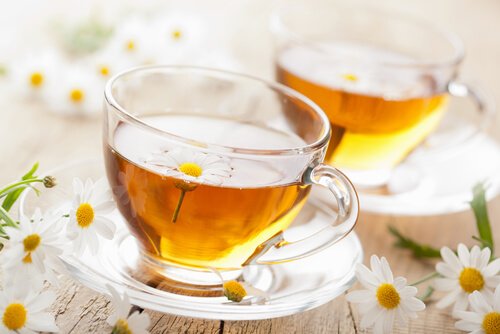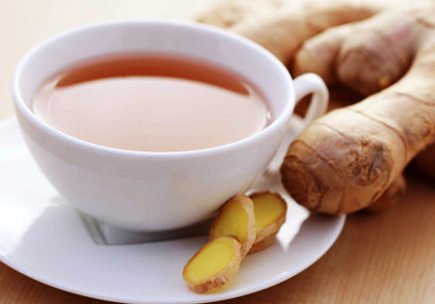5 Hot Drinks to Soothe Menstrual Cramps


Written and verified by Doctor Carlos Fabián Avila
Menstruation normally happens once a month. Unfortunately, many women experience pain, cramps, and overall discomfort. However, you should know that there are some methods to soothe menstrual cramps, such as hot drinks.
Naturally, we first recommend following a healthy diet to prevent and treat menstrual cramps. Additionally, it’s best to avoid drinking caffeine during your menstrual period, as it can cause anxiety and make you retain water.
In addition to avoiding coffee, you can use other types of drinks that have great benefits for women’s health. These teas will be great allies to you.
Hot Drinks to Soothe Menstrual Cramps
Although women tend to resort to painkillers to soothe menstrual cramps, it’s possible to relieve pain naturally. Therefore, we’ll give you a list of the best drinks to relieve your period pain.
1. Chamomile Tea

The first of the hot drinks to soothe menstrual cramps on our list is chamomile tea. Keep in mind that it contains two compounds called hippurate and glycine.
These compounds can help relax your uterus when you have cramps because of their properties. In addition, chamomile has unique anti-inflammatory properties that can help reduce discomfort.
- To make chamomile tea, you need a cup of hot water.
- Then, steep a bag of chamomile tea for 10 minutes.
- Next, remove the tea bag, and add lemon juice or honey.
We recommend you drink two cups every day during the week before your period. In fact, there is research that confirms that chamomile contains terpenoids and flavonoids with anti-inflammatory effects.
2. Ginger Tea to Soothe Menstrual Cramps

Second, ginger tea is another hot drink that can work wonders to soothe menstrual cramps.
Like chamomile, it has anti-inflammatory properties, so it can help with painful cramps,since it plays a key role in reducing prostaglandin levels.
Also, if your period is accompanied by nausea, upset stomach and general discomfort, ginger can help alleviate these problems.
You can increase your consumption of ginger by adding it to soups or shakes. However, we think that ginger tea is the most delicious way to consume it. As an additional benefit, it also helps regulate irregular periods, as well as combat fatigue.
Did you know?: Ginger and Olive Oil Syrup to Relieve Pain
3. Cinnamon Tea

Third, we have cinnamon tea. This tea is fantastic because it has anti-inflammatory properties. We ‘re positive that it will help you soothe menstrual cramps.
Ingredients
- 1 cup of water (250 ml)
- 1 teaspoon ground cinnamon (5 g)
Preparation
- First, heat a cup of water and add a teaspoon of ground cinnamon.
- Then, let it soak for about two or three minutes.
- If you want, you can also add honey to the tea.
You can drink it three times throughout the first day of your menstrual period.
4. Mint Tea
Mint tea is another great option. In fact, consuming it helps calm your stomach and prevent swelling and bloating.
Its soothing and numbing effect makes it useful to soothe menstrual cramps. Additionally, it helps treat headaches and gastrointestinal problems.
Numerous studies have confirmed that mint relaxes the uterine muscles, therefore soothing the spasms that cause cramps. As an added benefit, this drink is very delicious. We recommend that you drink it a week before your period.
You can drink four to five cups of this tea every day.
Don’t miss out: 5 Natural Home Remedies for a Heavy Period
5. Raspberry Leaf Tea
Lastly, we recommend using raspberry leaf tea to soothe menstrual cramps. Although it’s one of the least common varieties of tea, it’s very tasty and has the potential to reduce pain during your period.
Also, raspberry leaf tea has anti-inflammatory properties, so it’s useful in combating stomach pains and preventing constipation.
Finally, remember that our list of hot drinks to soothe menstrual cramps includes some remedies that can be very useful. However, there are many more out there.
We’re sure that you’ll find a hot drink that works best for you and reduce your period pain.
All cited sources were thoroughly reviewed by our team to ensure their quality, reliability, currency, and validity. The bibliography of this article was considered reliable and of academic or scientific accuracy.
-
- Rivas-Díaz, K., Loarca-Piña, M. G. F., Mendoza-Díaz, S., Reynoso-Camacho, R., & Ramos-Gómez, M. (2010). Revista mexicana de ciencias agrícolas. Revista mexicana de ciencias agrícolas (Vol. 3). Instituto Nacional de Investigaciones Forestales, Agrícolas y Pecuarias. Retrieved from http://www.scielo.org.mx/scielo.php?script=sci_arttext&;pid=S2007-09342012000300006
- Jaafarpour M, Hatefi M, Najafi F, Khajavikhan J, Khani A. The effect of cinnamon on menstrual bleeding and systemic symptoms with primary dysmenorrhea. Iran Red Crescent Med J. 2015;17(4):e27032. Published 2015 Apr 22. doi:10.5812/ircmj.17(4)2015.27032
- Gómez Estrada, H., Gonzalez Ruiz, K., & Medina, J. (2011). Actividad Antiinflamatoria de Productos Naturales. Boletin Latinoamericano y Del Caribe de Plantas Medicinales y Aromáticas-, 10(3), 182–217. https://doi.org/10.1016/j.jep.2010.05.059
- Jengibre. (n.d.). Https://Www.Botanical-Online.Com/Medicinalsgengibre.Htm. Retrieved from https://www.botanical-online.com/medicinalsgengibre.htm
- J Psychopharmacol. 2015 Dec; 29(12): 1236–1247. Caffeine consumption and self-assessed stress, anxiety, and depression in secondary school children. doi: 10.1177/0269881115612404
Int J Mol Med. Author manuscript; available in PMC 2010 Dec 1. Published in final edited form as: Int J Mol Med. 2010 Dec; 26(6): 935–940. Chamomile, an anti-inflammatory agent inhibits inducible nitric oxide synthase expression by blocking RelA/p65 activity. doi: 10.3892/ijmm_00000545 - Jenabi, Ensiyeh & Ebrahimzadeh, Samira. (2010). Chamomile tea for relief of primary dysmenorrhea. Iranian Journal of Obstetrics, Gynecology and Infertility. 13. 39-42. https://www.researchgate.net/publication/286965003_Chamomile_tea_for_relief_of_primary_dysmenorrhea
- Mol Med Report. Author manuscript; available in PMC 2011 Feb 1. Published in final edited form as: Mol Med Report. 2010 Nov 1; 3(6): 895–901. Chamomile: A herbal medicine of the past with bright future. doi: 10.3892/mmr.2010.377
- Int J Prev Med. 2013 Apr; 4(Suppl 1): S36–S42. Anti-Oxidative and Anti-Inflammatory Effects of Ginger in Health and Physical Activity: Review of Current Evidence. https://www.ncbi.nlm.nih.gov/pmc/articles/PMC3665023/
- Integr Med Insights. 2016; 11: 11–17. Published online 2016 Mar 31. The Effectiveness of Ginger in the Prevention of Nausea and Vomiting during Pregnancy and Chemotherapy. doi: 10.4137/IMI.S36273
- Clinical Study | Open Access. Volume 2014 |Article ID 792708 | 5 pages. Effect of Treatment with Ginger on the Severity of Premenstrual Syndrome Symptoms. https://doi.org/10.1155/2014/792708
- J Clin Diagn Res. 2015 Apr; 9(4): QC04–QC07. Published online 2015 Apr 1. Comparative Effect of Cinnamon and Ibuprofen for Treatment of Primary Dysmenorrhea: A Randomized Double-Blind Clinical Trial. doi: 10.7860/JCDR/2015/12084.5783
- Phytother Res. 2006 Aug;20(8):619-33. A Review of the Bioactivity and Potential Health Benefits of Peppermint Tea (Mentha Piperita L.). doi: 10.1002/ptr.1936.
- Iran J Nurs Midwifery Res. 2016 Jul-Aug; 21(4): 363–367. Evaluation of mint efficacy regarding dysmenorrhea in comparison with mefenamic acid: A double blinded randomized crossover study. doi: 10.4103/1735-9066.185574
- Clinical Pharmacology During Pregnancy. 2013, Pages 383-394. https://www.sciencedirect.com/science/article/pii/B9780123860071000234
This text is provided for informational purposes only and does not replace consultation with a professional. If in doubt, consult your specialist.








